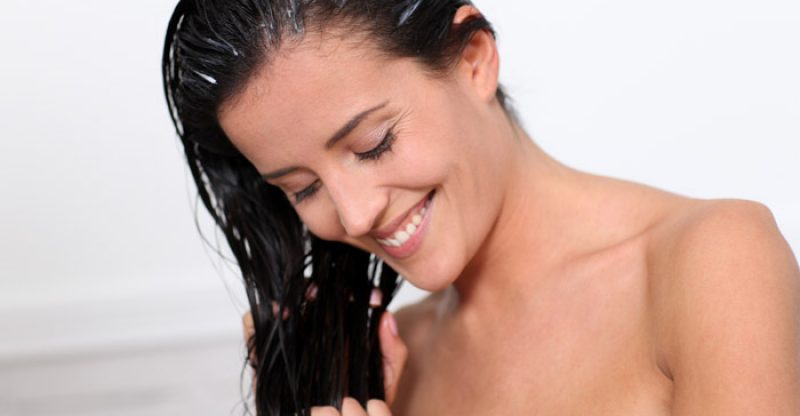Keratin Treatment Side Effects and Natural Alternatives
For everyone out there with thick, textured, or unruly hair, if you are considering straightening your hair with a keratin treatment, you may want to think again.
Brazilian keratin treatments are dangerous to your health and your hair.
There are many dangers associated with this famous but toxic hair treatment, and while the results for your hair are impressive, it is not worth the risk to your health.
Read our guide to understand all the health risks associated with keratin treatments, and learn how to achieve healthy, straighter hair at home using natural treatments, instead.
If you’ve ever been in a salon and seen an advertisement for Brazilian hair straightening, the ad likely included a photo of a woman with long, thick, straight, shiny hair.
On the surface, this seems like a great thing, especially if you have unruly hair.
But the little-known truth behind these treatments is that they use toxic chemicals that can harm you and your stylist, they can severely damage thin hair, and they are often not even labeled with the ingredients they actually contain.
What is Keratin?
Keratin is the natural element that comprises your hair, skin, and fingernails.
It is a fibrous protein that is the essential building block for all of these cells.
In the animal world, keratin is also found in hooves, horns, feathers, and wool, which are animal equivalents of hair, skin, and nails.
There are two main types of keratin.
The kind found in human skin, hair, and nails is called alpha-keratin.
All keratin cells are comprised of large amounts of cysteine, an amino acid containing sulfur.
Think about the smell of burning hair, and it will not surprise you that hair is 14 percent cysteine.
Beta-keratin is found in animal hide and external body parts, like beaks and claws.
Because it is strong, keratin is an essential building block for healthy hair.
When your hair is brittle or lifeless, you probably lack the necessary keratin in your body to keep your hair healthy.
How Does Keratin Work?
The purpose of keratin treatments is to straighten and smooth hair.
The process is semi-permanent, lasting several months.
To accomplish the goal of smoother hair, a stylist will smooth a liquid keratin complex onto your hair and seal it into your hair follicles with a flat iron set to a very high temperature.
Keratin hair straightening usually takes about 90 minutes to complete, but may take more time if you have very long hair.
Keratin treatments work best for those with frizzy or curly hair that is thicker and highly textured.
Thin, straight hair often cannot withstand the high heat of keratin treatments.
All of this may sound like an excellent option if you want straighter hair.
But this treatment is not without its dangers and cautions.
Dangers of Keratin Treatments
Keratin straightening has been banned in several countries, include the European Union and Canada.
Other countries have issued warnings or regulations regarding the use of keratin products.
But if the results are so positive, what is the problem?
Unfortunately, keratin is not the only ingredient used in these formulas, and the additional elements, which include formaldehyde, pose serious health risks both to those getting the treatments and to hair stylists and other salon patrons.
Formaldehyde is the most common preservative used in keratin treatments, and even those formulas that are labeled formaldehyde-free can still produce formaldehyde when exposed to the high heat of the styling iron.
In the US, the Federal Occupational Safety and Health Administration, known as OSHA, has issued a warning regarding Brazilian keratin treatments, and they even added an informational site just for this important health topic.
Many salon owners and stylists have become ill from exposure to the harsh chemicals in these treatments, and consumers need to understand this beauty treatment’s potential risks.
OSHA investigations have determined that salons that perform keratin straightening treatments often have dangerously high levels of formaldehyde in the air.
This is true even when they are using products that are labeled formaldehyde-free (1).
A 2011 survey by the Environmental Working Group surveyed nearly 50 salons using hair straightening treatments.
Even when the salon owners thought they were making better choices by selecting products free of formaldehyde, their salons, and therefore their stylists and patrons, were still being exposed to harmful fumes containing the cancer-causing agent (2).
Understanding Formaldehyde Exposure
Formaldehyde is classified as a human carcinogen.
While our bodies actually can make a small amount of formaldehyde in our cells, the formaldehyde we breathe is what is most dangerous.
Formaldehyde, which is found in tobacco smoke and is produced by burning wood and fossil fuels, is toxic to our lungs, noses, and airways (3).
Many international organizations, including the International Agency for Research on Cancer and the National Toxicology Program, have expressed concerns over the use of formaldehyde and formaldehyde-producing ingredients in this popular but dangerous salon treatment.
The Centers for Disease Control and Prevention (CDC) warns that smelling formaldehyde causes a cough, sore throat, itchy eyes, and nosebleeds.
It is carcinogenic, known to cause cancer of the nose and throat.
Those with known sensitivities or who are exposed for long periods of time, like stylists who work at salons where keratin treatments are regularly performed, are at higher risk for suffering reactions to and developing cancer from formaldehyde (4).
Even if formaldehyde levels are low and do not cause symptoms, you can still develop cancer from exposure.
In addition to concerns regarding cancer and respiratory irritation, exposure to formaldehyde has also been linked to other serious health problems.
A 2015 study examined the connection between formaldehyde exposure and increased rates of ALS, or Lou Gehrig’s disease.
Those who experience regular exposure to the chemical, such as funeral directors who work with embalming fluid, are more than three times as likely to have the deadly central nervous system disorder.
Formaldehyde may also cause headaches, changes in mood, insomnia, impairment of memory, trouble with balance, irritability, and depression because of its impact on central nervous system function (5).
Other warnings about formaldehyde exposure include advice to pregnant women not to have keratin hair treatments, as formaldehyde can cause miscarriage and other reproductive problems (6).
Anyone with bronchitis, asthma, or other breathing conditions will be sensitive to exposure because formaldehyde irritates the airways and mucous membranes.
Salon owners and stylists are at the most significant risk for the long-term effects of formaldehyde exposure.
Anyone who has this treatment done regularly spends time in salons that perform keratin hair treatments, or who is a stylist who does this treatment, is at risk from exposure to this hazardous chemical.
If you choose to have a keratin hair straightening treatment, your exposure does not end at the salon.
Every time you expose your hair to heat, whether from a blow dryer or flat iron, you will release the same chemicals as during your original treatment.
Many who have had this treatment have developed extreme sensitivities and allergies afterward.
In the US, Brazilian hair straightening chemicals can contain up to 0.2 percent formaldehyde and still be labeled safe.
Because of the warnings and bans issued by so many Western countries, some companies have started selling formaldehyde-free keratin straightening products.
While these sound like an excellent alternative to the hazardous chemicals just discussed, they may not offer much hope.
What About Formaldehyde-Free Products?
A 2013 research study chemically analyzed ten of the most popular keratin hair-straightening products used in salons in the US.
Seven of the ten products recorded formaldehyde levels exceeding the legally safe amount, with an average concentration of 1.46 percent (7).
This includes several products that were labeled as formaldehyde-free on their packaging.
How is this possible?
Once manufacturers realized they could no longer legally sell products containing formaldehyde in some of their top-grossing countries, they replaced this ingredient in their Brazilian keratin treatments with others, usually methylene glycol.
Unfortunately, when exposed to heat, methylene glycol releases formaldehyde.
When seven Brazilian keratin products were analyzed in 2014, six produced levels of formaldehyde over five times the acceptable limit.
Five of these products were labeled as formaldehyde-free (8).
While the labels for these products are accurate in stating they contain no formaldehyde, that does not mean that formaldehyde is not released when the products are used.
The health risks remain high for these so-called formaldehyde-free products.
While some brands that produce Brazilian hair treatments are creating true formaldehyde-free products, such as Cezanne’s Keratin Smoothing Treatment, many more are still trying to pass off dangerous chemicals as safe for use.
It may be some time before the industry can regain the trust of clients and stylists who have been exposed to these unwanted effects.
Other Risks from Keratin Treatments
Besides the risk of exposure to formaldehyde and formaldehyde-producing chemicals in these products, Brazilian hair treatments can also damage hair in other ways.
The high heat of the flat iron used often exceeds 450 degrees.
This can damage and even burn hair, particularly very fine or thin hair.
When you consider the very real costs in dollars and potential harm to your health, you may be wondering why anyone would choose this hair treatment.
If you have decided that a keratin straightening treatment is not worth the risk, you may want to consider one of these other natural ways to get straighter, smoother hair at home for a fraction of the cost.
Natural Alternatives to Keratin Treatments
While there is more attention to the dangers of Brazilian hair treatments that contain or produce formaldehyde, it is not enough to ban the use of this product in the US.
A current lawsuit is hoping to protect salon workers from formaldehyde exposure by forcing the FDA to enforce harsher guidelines regarding the use of these treatments.
If you want to protect yourself and those who work in salons from formaldehyde exposure, there are many ways you can achieve straighter, more manageable hair at home, without the dangers already discussed.
- You are What You Eat, and So is Your Hair
Your overall health will be reflected in that of your hair.
If you are eating a healthy diet, rich in vitamins and nutrients, your hair has the building blocks it needs to be healthy.
Getting sufficient, quality protein will help your body have the keratin it needs to make strong, healthy hair, too.
Other important nutrients for healthy hair include vitamin E, copper, magnesium, selenium, and iron.
- Use Natural Keratin Products at Home
There are many topical keratin products you can use at home that will help you achieve straighter, smoother hair.
Use keratin-rich shampoo, conditioner, and hair products, and your hair will benefit from the smoothing, straightening, and repairing effects of keratin at home.
And you won’t have to worry about formaldehyde or other harmful ingredients.
- Coconut Oil Prevents Frizz
Heat and styling can cause significant damage to hair.
Coconut oil has been proven to strengthen hair, preventing damage and improving hair’s overall condition (9).
It can even tame your frizz.
After washing your hair, take a small dab – less than a teaspoon depending on your hair length – and rub it into your palms to warm it.
Then, smooth your hair from root to tips with your hands. Blow dry and style as normal.
While it may take a bit longer to dry, your hair will be manageable, shiny, and soft after this treatment.
Applying just a bit to split and frizzy ends is a great way to touch up hair, too.
You don’t need much to make a big difference for fly-aways and frizz.
- Make a Mask for Your Hair
Nourishing hair masks, made with all-natural ingredients, can help tame your locks and give you silkier, shinier tresses.
Here are five quick, easy, and inexpensive hair masks you can make at home.
- Banana and Honey – Mash one banana, then add some honey, a half cup yogurt, and two tablespoons of olive oil. Mix to combine. Apply to your hair, wrap in a towel, and let it sit for one hour. Rinse your hair with water and allow it to air dry.
- Almond Milk – In a small saucepan, combine ½ cup almond milk, 2 teaspoons extra virgin olive oil, and whisk in 3 tablespoons of cornstarch. Warm the mixture on low until thickened. Remove from heat and cool until lukewarm. Massage into hair and cover with a shower cap. Wait 20 minutes. Wash with warm water and shampoo.
- Coconut Milk – In a jar, mix one cup of fresh coconut milk and the juice of one lemon. Allow the mixture to rest in the refrigerator until there is a creamy layer on the top, usually 1-2 hours. Massage into your hair and scalp, cover with a shower cap and wrap your head with a warm towel. Leave on for 20 minutes. Shampoo and condition your hair as usual.
- Eggs and Olive Oil – Beat two eggs in a bowl and add four tablespoons of olive oil. Apply thoroughly to hair and scalp. Comb out the tangles, cover with a shower cap, and leave on for 30 minutes. Wash and rinse as usual.
- Aloe Vera – Mix a half cup of aloe vera gel with a half cup warm olive oil. Massage into your hair and scalp, cover with a shower cap and leave for one to two hours. Wash and rinse hair as usual.
There are many recipes available online for natural hair masks, so experiment with ingredients that work best for your hair type and need.
Ingredients that are beneficial to hair also include gelatin, yogurt, avocado, honey, and essential oils.
Have fun making your own recipes until you find the perfect combination for your hair.
- Milk
Milk’s protein can strengthen hair, while its fat moisturizes. Mix equal parts milk and water in a spray bottle.
Spray your hair, combing out tangles and spraying all hairs from root to tip.
Let this soak in for about 30 minutes, then wash your hair as usual.
- Fuller’s Earth Clay Can Straighten Your Hair
The chemical properties of Fuller’s earth make it an excellent straightening agent.
Take a small amount of the clay and add water to make a paste. Apply all over your hair and scalp to cover adequately the roots.
Using a wide-toothed comb, comb out your hair, straightening it as you comb.
Let the paste sit for one hour, then rinse with warm water.
An alternative to this treatment is to mix the clay with one egg white and two tablespoons rice flour.
Make a paste using water to create a thin consistency. Apply as above and let dry for one hour.
Rinse with warm water, then spray your entire head with milk, letting it soak for 15 minutes.
Wash your hair as usual.
- Deep Condition Overnight
Deep condition your hair once a week to restore moisture and help hair stay healthy.
Warm five to ten drops of argan oil on your fingertips, then massage into your scalp and down your hair strands, working the oil into all of your hair.
Wear a shower cap over your hair, and go to sleep.
The argan oil will penetrate into your hair because of your natural body heat, and your pillowcase won’t get stained or oily, either.
Wash your hair, as usual, the next morning.
This treatment works well for dandruff, too, but should be used twice a week until your dandruff disappears.
Once your dandruff is gone, use just once a week to maintain results.
- Massage in Essential Oils
Essential oils like rosemary, sage, and cedar wood can help your hair grow healthier and stronger while also moisturizing your scalp.
Many natural shampoos already contain essential oils, as well.
Massage oils into your scalp and hair, following the procedure described above for argan oil.
Experiment with oils until you find those that work best for your hair type and produce the results for which you are looking.
- Agave Nectar Smoothing Gel
Even though it is lightweight, agave nectar has the ability to deep condition hair.
To make your own agave smoothing treatment, combine ¼ cup agave nectar, 2 tablespoons olive oil, and 1 tablespoon coconut oil.
Massage the mixture into your hair, combing through to the ends. Cover with a shower cap and a warm towel.
Let this sit for 15 minutes, then rinse and wash as usual.
Precautions
There are several pending lawsuits and claims with OSHA regarding the use of formaldehyde-containing and producing products in hair salons.
Among the products listed as the most significant culprits for formaldehyde exposure are:
- Brasil Cacau Cadiveu;
- Brazilian Blowout (Acai Professional Smoothing Solution, Professional Brazilian Blowout Solution);
- Marcia Teixeira (Advanced Brazilian Keratin Treatment, Extreme De-Frizzing Treatment);
- Keratin Complex Smoothing Therapy (Natural Keratin Smoothing Treatment, Express Blow Out, Natural Keratin Smoothing Treatment Blonde);
To completely avoid formaldehyde or formaldehyde-producing ingredients, stay away from anything containing:
- Formalin;
- Formic aldehyde;
- Methanal;
- Methylene glycol;
- Methylene oxide;
- Paraform;
- Oxomethane;
- Oxymethylene;
- CAS Number 50-00-0.
OSHA has also warned that timonacic acid, or thiazolidine carboxylic acid, releases formaldehyde under the circumstances like those used in the hair straightening process.
Before having your hair straightened professionally, ask to see the label for your straightening product to check for any of these ingredients.
Since it is nearly impossible to achieve the same hair-smoothing results without these chemicals, it may be difficult to get the results you want.
Doctors warn that those with seborrheic dermatitis or psoriasis should check with their dermatologist before using keratin treatments, either at home or in the salon.
You should always perform a patch test to determine if your skin may be sensitive to the ingredients in either salon or home treatments.
Conclusion
By now, you may likely see the dangers associated with keratin straightening treatments and are hopefully considering other more natural solutions to your hair woes.
Consider the risk and the reward.
Is having straight hair worth compromising your health and that of your stylist?
While natural remedies may require a little more effort, they are better for you, for others, and for your hair in the long run.
FDA Compliance
The information on this website has not been evaluated by the Food & Drug Administration or any other medical body. We do not aim to diagnose, treat, cure or prevent any illness or disease. Information is shared for educational purposes only. You must consult your doctor before acting on any content on this website, especially if you are pregnant, nursing, taking medication, or have a medical condition.
HOW WOULD YOU RATE THIS ARTICLE?






